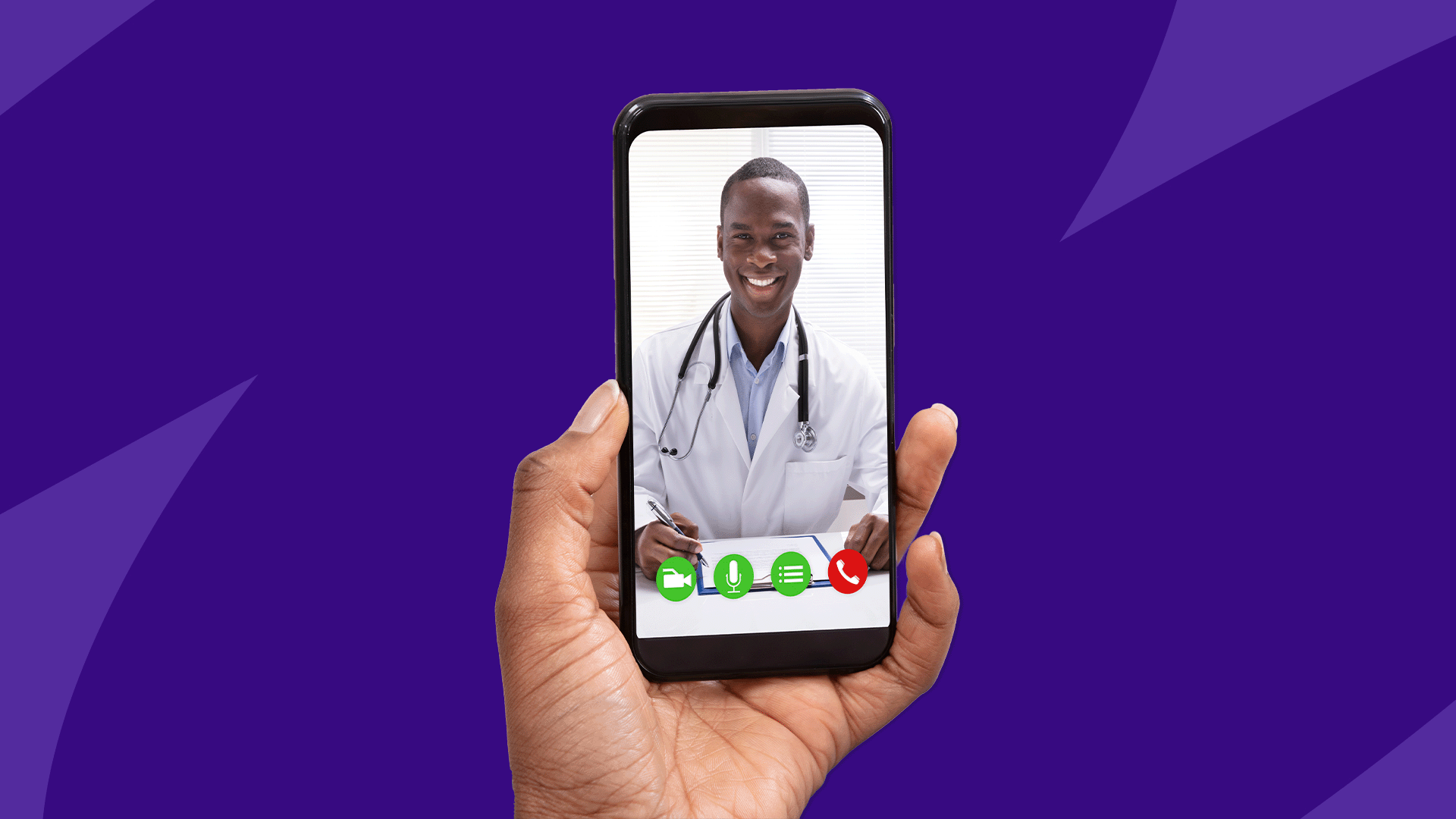In a study conducted from April to October 2021, 23.1% of U.S. citizens reported using telehealth services in the previous four weeks. While telehealth became popular during the pandemic, rates of telehealth use vary across different demographics. One reason may be that some are unfamiliar with the practice or may not know it’s available in their area. Medicaid and Medicare recipients were the most likely to use telehealth, with younger and uninsured patients less likely to participate.
Part of making telehealth a widely-accepted aspect of healthcare is to increase awareness about it. Here are some facts about telehealth, how it’s used today, and what you can do to take advantage of telehealth opportunities.
What is telehealth?
Telehealth is the use of online or telephone communications to deliver healthcare services. Although telehealth often involves a live video or phone call with a provider, some aspects of telehealth include the use of remote health monitoring technology and the use of specific platforms to message a healthcare provider. Email and secure message platforms help patients communicate with their healthcare providers when real-time options aren’t available. Telehealth easily connects a patient and healthcare provider when in-person visits are unavailable or there are issues with transportation to a clinical or doctor’s office. Distance is not an issue with telehealth.
Difference between telehealth and telemedicine
While the terms telemedicine and telehealth are used interchangeably, the American Academy of Family Physicians (AAFP) differentiates between the two terms:
- Telemedicine refers to technology used to remotely provide clinical services to a patient. Telemedicine services are typically provided by a physician and usually involve diagnostic, monitoring, and treatment services.
- Telehealth refers to a broader range of services than telemedicine. It may include providing clinical or non-clinical services, provided by pharmacists, nurses, or social workers.
The AAFP recognizes telemedicine, provided within the context of accepted standards of care, as an appropriate and efficient way to improve health.
What is telecare?
There’s one more term you may have heard: Telecare specifically refers to consumer health and fitness apps. Telecare often involves the use of devices, tools and apps that monitor different aspects of a patient’s health. Telecare technology includes video monitors, heart trackers, medical alarms, and any tool that helps care providers check on a patient or give real-time data to the provider remotely.
Telecare is generally limited to patients who are too high risk to wait long between visits but aren’t candidates for 24/7 medical care. It allows them to live independently while reducing risks to their health. A heart condition, for example, can be monitored while a patient stays home, reducing costs and disruption to their lives.
Types of telehealth
Telehealth comprises different methods of receiving remote care.
Live appointment with doctor or specialist
Appointments can take place in real time, just as you would interact with a physician in person. Appointments are carried out over the phone or through a video conference. This method of care offers a convenient way to communicate and can allow the care provider to assess the patient remotely through messaging, video documentation, and photos.
Asynchronous appointments
Real-time appointments aren’t always possible. Asynchronous telehealth appointments let patients and providers chat through messaging platforms, chat apps, or recorded videos that can be reviewed when it’s convenient for both the patient and the care provider. This type of communication is delayed, however, and may not be appropriate for urgent care needs.
Remote patient monitoring
Sometimes, a care provider needs a clear and consistent picture of what’s going on with a patient over time. Remote patient monitoring uses technology to track and capture health data over a period of time. Heart, blood pressure, and sleep monitors are examples of ways that physicians can diagnose and monitor patients remotely.
Mobile health
When a health professional wants continued data tracking and collection, mobile health apps and devices may be used. Apple Watches, for example, can measure heart rate, physical activity, and oxygen levels. The accompanying apps create reports for physicians and specialists to review before the next visit.
What can telehealth be used for?
Any interaction where specialized diagnostic tools or up-close physical examinations aren’t required can be a good opportunity to use telehealth. Currently, health providers can use telehealth for different scenarios.
- Deliver lab or diagnostic test results
- Diagnose skin conditions
- Treat minor conditions, such as the common cold
- Manage medications
- Proctor and evaluate COVID-19 tests
- Perform mental health services including talk therapy
- Offer post-procedure instructions and follow-up care
While not all urgent care needs can be handled through telehealth services, many common health issues—such as common viral illnesses, ear infections, and digestive issues—can be handled without the patient ever coming into an office or clinic. Diagnosing and treating conditions that don’t require specialized equipment or physical examination by a healthcare provider can conveniently be done through telehealth services.
Telehealth has become a popular option for follow-up visits where patients can update their providers with any new or existing health concerns and how any previously prescribed treatments are working. A patient could get bloodwork done at a lab or through a nursing visit, then have those results sent ahead to the provider so that any treatment adjustments can be made through telehealth. This saves the patient having to make multiple visits and is more efficient for the provider.
Telehealth for behavioral and mental health services
Mental health services and psychiatric care can be managed through telehealth. With telehealth, providers can maintain the quality of care for patients who can’t travel or who would otherwise not get the care they need through face-to-face visits. Behavioral health is a good fit for telemedicine since much—if not all—of the consultation can be carried out through video communication.
Psychiatric conditions, from ADHD to depression, can be treated through telehealth visits. Telehealth therapy is also an effective steppingstone for patients at a long-term care facility who are transitioning to living on their own but need regular check-ins to evaluate their progress.
Telehealth for physical health
Physical health problems can also be managed through telehealth. While some diagnostic tasks can’t be done through video (and need specialized skills and equipment to get the right data), many of the common conditions people see a healthcare provider for today may be treated with telehealth services.
From acute diagnoses to ongoing care, telehealth services are becoming more common for clinical purposes. Patients seen in a hospital or emergency room setting may be released to their homes sooner, knowing they will get ongoing care. Telehealth helps fulfill the need for ongoing care and reduces the chance that released patients will “fall off the map” or fail to return for follow-up care.
In-person visits with a physical therapist can shift to virtual coaching and regular assessments after physical exercises are learned by the patient.
Benefits of telehealth
While telehealth became a necessity during COVID, it has proven to have benefits in a post-pandemic era.
Better access to healthcare
As care facilities merge and smaller clinics and hospitals close, it’s becoming hard for rural and remote areas of the country to offer care options for their residents. Telehealth closes the gap, giving patients from all parts of the country a way to connect with quality physicians and nurses. It also eliminates the need for long drives to urban areas, which can be difficult for older patients, low-income patients, people with mobility issues, and underserved populations.
Lower cost of healthcare
Telehealth can give care providers a more efficient way to care for patients and can be done from anywhere. In areas where real estate is expensive, telehealth reduces the need for large patient rooms and waiting areas and makes it cheaper to maintain facilities. Physicians at low-volume facilities can utilize telehealth technology as needed, which can reduce costs since there is less of a need to be working onsite at all times.
More convenient
It’s not uncommon for a patient to put off much needed care because they can’t afford to take off work or spend the time en route to a clinic. For chronic care needs, especially, telemedicine gives patients a way to quickly check in with their provider, eliminating long wait and commute times, and avoiding the need to skip a day of work.
Access to more professionals
Before telehealth, patients were limited to the healthcare providers available at their local doctor’s office, clinic, or hospital. The providers they could see were those on duty at the time they needed care. Today, telemedicine lets patients have more options in the providers they can consult with, even if those providers are located in another state. If a patient visits a provider for a consultation and wants a second opinion, getting additional expertise is just a phone call or video call away.
Reduces the spread of illness
While COVID restrictions highlighted the potential for telehealth to reduce disease transmission, the benefits of telehealth have become more apparent and the practical applications will remain long after the pandemic is controlled. For examples, when an immunocompromised patient doesn’t want to risk getting ill, telehealth offers an option to avoid becoming seriously ill after visiting a packed doctor’s office.
Encourages reluctant patients to be proactive with care
It can be difficult for some people to stay on top of their treatments, especially if they see multiple providers for chronic conditions. Through the use of telemedicine services, patients can conveniently speak to their providers as needed without having to make multiple in-person visits. The ease of telemedicine services allows patients to be more proactive about their health care and adhere to their treatments.
Protects privacy
Especially in small communities, where people are likely to run into people they know, telehealth provides some measure of confidentiality to an otherwise public visit to an office or hospital. With visits taking place in the privacy of your home, no one has to know why you are seeking certain healthcare services unless you tell them.
Telehealth FAQ
Here are some commonly asked questions regarding telemedicine.
Can you get prescriptions through telehealth?
Yes, many healthcare providers prescribe medications through telehealth visits. Many patients opt to use a quick telehealth visit to renew an expired prescription. For new patients, many healthcare providers prefer an initial in-person visit before prescribing a new medication. Controlled substances, such as prescription pain medications, are rarely—if ever—prescribed without seeing a healthcare provider face-to-face. Office rules and regulations will vary.
Is telehealth covered by insurance?
Telehealth, when offered by a provider that’s listed under your current plan, should be covered by insurance. If you are unsure, check with your insurance company. They may have a separate telehealth partnership with a network of specific providers that offer telehealth services. Ask your insurance company how they handle telehealth visits and whether your primary care doctor needs to be involved.
Does my doctor offer telehealth?
While telehealth is growing, as many as 43% of patients don’t know if their provider offers it. Websites and advertising may not be updated, and the best way to know is to ask. When inquiring, find out what options are available (video, phone, email) and when it would be best to use telehealth versus visiting in person. Your healthcare provider will help determine how your plan will cover telehealth visits and in-person consultations.
More resources on telehealth
If you’re not sure where to go for more information on the telemedicine services available to you, there are a couple places to start.
- Check with your provider, who likely has guidelines for when to use these services and how to initiate them.
- Check with your insurance company, who may have preferred telehealth networks, or a special pricing plan for using these services. Some may reduce the office copay. Others may not make you pay a deductible before getting benefits.
From there, you may have special technology requirements to get the best experience. Your computer or phone should be updated with the latest operating system and video technology. Your physicians may have a preferred telehealth app that they recommend, as well. If you have questions about whether your technology will work, reach out to your healthcare provider’s front desk or customer service team prior to your visit. Working out the technical bugs before you meet with your provider ensures you get the most out of every minute and don’t sacrifice the quality of care.
This telehealth survey also offers additional insight into how other patients view the trend, what questions they have, and some questions you may want to ask about the next time you visit your doctor. As you get used to the idea of telemedicine, it may become commonplace for some types of care. In the end, it’s up to what you feel comfortable with and is not a complete substitute for in-office visits.











